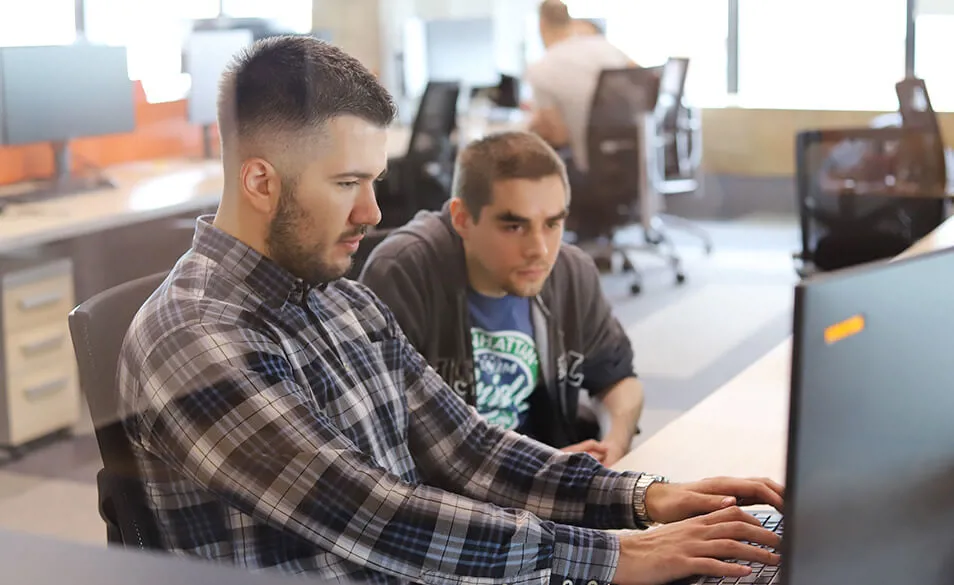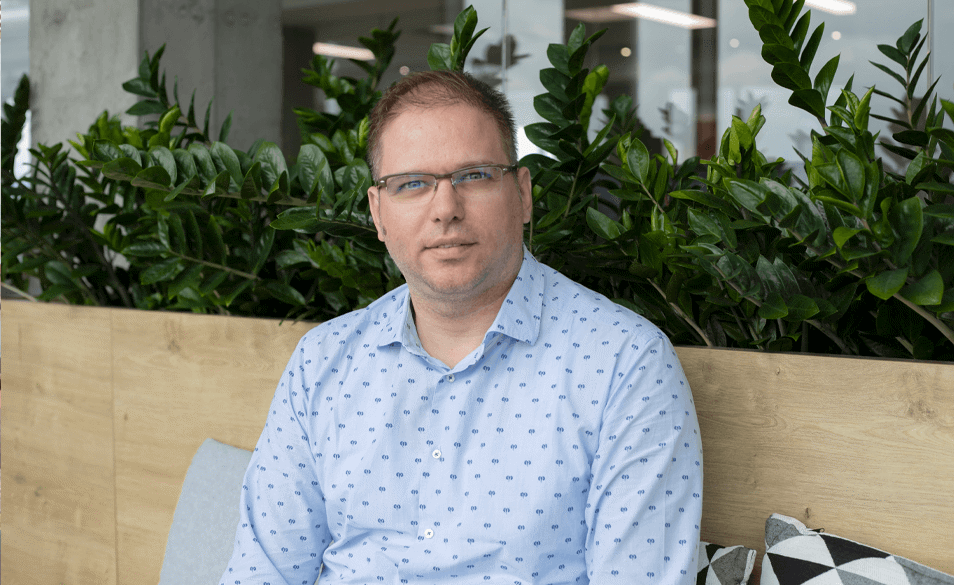How to think in software product development terms to build better projects

Software products now account for the vast majority of our service interactions, work, and free time. You've likely used as many as a dozen software products already today and, where they've worked well, you probably didn't notice them at all. Effective software product development looks at more than just engineering to envision how software will fit seamlessly into users' lives.
Products that meet the needs of their users reliably quickly become an integral part of how they think about services. Products that are ineffective, cumbersome, or unreliable are quickly replaced with something better. This is as true for physical devices as it is for software products. As a result, development teams have to understand so much more than just how to build software solutions.
Our software product development teams include designers, analysts, project managers, QA engineers, DevOps specialists, and test engineers specifically to envision projects as more than just a software testbed but as a functional part of user's daily lives.
Our partners often highly value our ability to proactively take ownership over features of our software products to analyze their impact and enhance the user experience.
Here, we use experience we've gained in the field to introduce you to software product development by outlining its key stages and highlighting the key components you should be thinking about when envisioning your software as a product rather than a project.
What is Software Product Development?
High-quality software product development depends on developing software solutions with the target audience of users firmly in mind. In some instances, it can be thought of as an alternate strategy to the technical challenges software engineering that focuses on problem-solving, discovery, and experimentation to overcome technology hurdles.
A key example of this development strategy being used to great success comes from a unified track and trace platform we built as a software product for one of our clients. By utilizing software product development in our teams we were able to create a secure yet highly customizable platform to serve end-user companies involved in supply chain logistics.
To do this well in new projects, we often break down software product development into a series of stages that helps to visualize the final product roadmap.
Stages of Software Product Development
Creating a product development plan for each of our projects helps to map the requirements and milestones of the project onto the final product. When finalized, it should define a comprehensive product roadmap and a clear route toward success.
Here, we've identified seven key stages common across software product development projects that ensure successful outcomes. These are:
1. Product Planning
If there's one "secret" to successful development across product development and general software engineering it lies in creating a detailed plan of what the project should do.
In product planning, this should outline the challenges the product is aiming to solve and conceptualize the design, scope, and interactions the product will have with its users. Some outcomes from the planning phase may include:
- User stories. Simplified descriptions of functionality that the software will provide for users
- Wireframes. A simple representation of how the user interface will work and the interactions it will enable.
- Product requirements document (PRD). A document that outlines the core features, functionality, and requirements for a software product.
- Project management chart. A roadmap of the expected time frame for the project's major milestones and dates
2. Product Research and Analysis
The requirements-gathering phase should begin to put some technical details and project milestones onto the product plan. If the product plan can be thought of as answering the question of what the project should do then the requirements gathering phase should begin to look at how the software should achieve it.
In many cases this means talking to the target audience, analyzing what competing products are already out there, and looking at what can be improved in competitors to deliver a better product. Our goal is to identify both functional and non-functional requirements. Some of the primary questions that we aim to answer during the requirements gathering phase of development include:
- What is the key functionality the product should achieve?
- How many users should the product support? How many simultaneous users?
- How should we expect to scale over time?
- What performance characteristics should the product achieve? How do we measure perfomance?
- What are the security and compliance requirements the product must meet?
- Arrive at an estimated timeline and cost for production.
- Decide how the product will be tested and validated after development.
- Decide how the product will be deployed and maintained long-term.
Answering these questions comprehensively will help align strategy and direction for development, testing, and beyond. They will inform the next stages of product development and help guide your software product toward features and functionality that really matter.
3. Design and Mockup
The design stage should begin to put answers and insights gained in the first phase of product planning and research into action. This phase involves building an underlying software architecture that will serve as a foundation for product in addition to laying out a robust user interface and user experience.
Despite being a relatively early phase of development, it's also the first opportunity teams have to begin testing their ideas for the product.
Design mockups can often be trialed with users that represent the target audience as a way to get real-world instant feedback that can ensure the product meets its stated goals.
4. Product Development
With many of the planning, technical, and interface challenges met it's finally time to begin construction. This phase is at the heart of all software projects regardless of the development methodology used or the product being built.
The development phase is most commonly the longest-lasting and most complex phase of product development. It is heavily informed by the previous three phases — relying on each to guide the technology solution, acceptance metrics, and overall goals that go into releasing the final product.
In an agile project, an initial working version of the software is built with few, if any, features included. This bare skeleton is then added to and refined iteratively as the project continues.
5. Testing and User Validation
With a working version of the software in hand, we can begin to undergo the test and verification steps that ensure a robust and reliable system in production. In most cases, as software gets further and further through the development phase the code that underpins it has already undertaken a significant amount of unit and integration testing.
Continuous integration testing is a fundamental part of how we build industry-leading software products today. This is a technology that enables us to ensure functionality, systems, and performance tests are taking place as project development is still underway.
The product testing phase is a chance for teams to perform usability tests, acceptance tests, and security tests amongst others to ensure the software being built both meets the specification and stands out amongst marketplace competitors as a well-built and highly capable product.
6. Deployment and Launch
With a software product that's been built and tested with its users at the forefront of thinking at every step along the way, we can begin the process of launching your product to meet its intended audience.
During this phase teams will often work in close collaboration with marketing and operations to arrive at a launch plan and schedule that maximizes impact in the marketplace. Some common strategies include launching to an initial close-knit audience of early-access subscribers to provide a preview to backers, gather initial interest from an invested audience, and iron out initial marketing or distribution issues.
In 2020 we launched the heartcount app, a software product built in conjunction with Woohoo inc to help companies better understand the health and wellbeing of their employees. Since its launch, the product has seen huge success — being picked up by more than two dozen companies across multiple languages and teams around the world.
7. Long-Term Maintenance
With your product finally launched to its audience you can finally turn your groundbreaking software product idea into a two-way conversation with its users. One of the unique things that differentiates software products from physical products is the potential for future iterations, upgrades, and increased service on the same platform.
Your users will very often tell you precisely what they want and how they want the system to improve, either in conversation, through social media, or by the way they use the product.
Attention, capability, and flexibility in this area are all richly rewarded. Well-built designs that have long-term maintenance and a robust software architecture built-in have enabled us to upgrade and service software projects for clients long into the future and maintain a highly relevant presence across many industries.
Thinking about Software from a Product Perspective
The way people think about writing, designing, and developing software is often vastly different from the way they think about using it. Often, people think about building software in lines of code and engineering features. In contrast, people use software as a product to meet a goal or access a service in daily life.
To have an impact in the software marketplace your engineering teams should be capable of thinking about development in terms of the products it creates for its users.
That's why we're particularly proud of our software product development teams and the solutions they have created in conjunction with our clients and partners. To find out what software product development can create for your audience get in touch today to talk technologies, solutions, and most importantly of all — software products.


